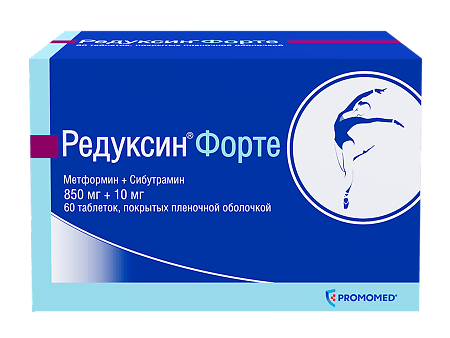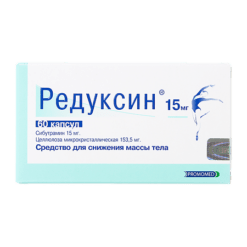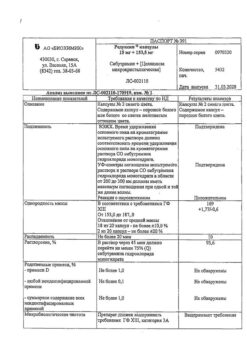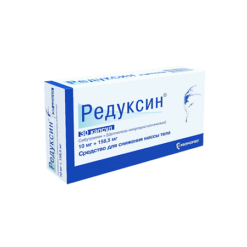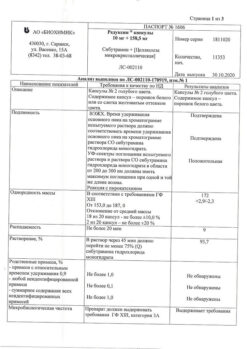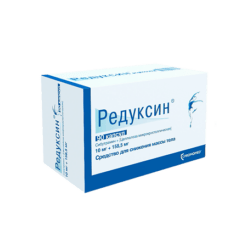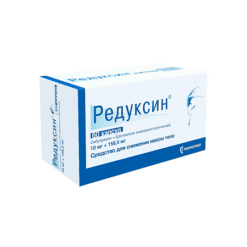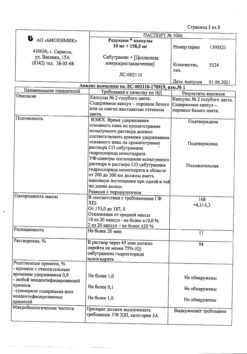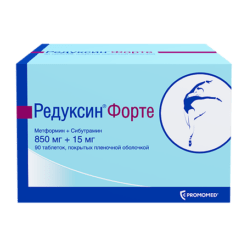No products in the cart.
Reduxin Forte, 850 mg+10 mg 60 pcs
€120.21 €100.17
Description
Pharmacotherapeutic group
Hypoglycemic agent of oral biguanide group. An agent for the treatment of obesity.
ATX code: A08A and A10BA02
Pharmacodynamics
Metformin
. An oral hypoglycemic drug of the biguanide group, reduces hyperglycemia without resulting in hypoglycemia. Unlike sulfonylurea derivatives, it does not stimulate insulin secretion and does not cause hypoglycemic effect in healthy people. Increases the sensitivity of peripheral receptors to insulin and glucose utilization by cells. Inhibits gluconeogenesis in the liver. Delays absorption of carbohydrates in the intestine and stimulates the production of GTP-1 (physiological regulator of appetite).
Metformin stimulates glycogen synthesis by acting on glycogen synthase. It increases transport capacity of all types of membrane glucose transporters. In addition, it has a favorable effect on lipid metabolism: it decreases concentrations of total cholesterol, low-density lipoproteins and triglycerides.
During metformin administration body weight remains stable or decreases moderately.
Sibutramine
It is a prodrug and shows its effect in vivo due to metabolites (primary and secondary amines) that inhibit monoamine reuptake (serotonin, noradrenaline and dopamine). The increase of neurotransmitters in synapses increases the activity of central 5NT-serotonin and adrenergic receptors and contributes to the physiological regulation of appetite by increasing the feeling of satiety and reducing the need for food, as well as increasing thermoproduction (internal energy expenditure). By activating β-adrenoceptors indirectly, sibutramine affects brown adipose tissue. Reduction of body weight when taking sibutramine is accompanied by an increase in serum concentration of high density lipoproteins (HDL) and a decrease in triglycerides, total cholesterol, low density lipoproteins (LDL) and uric acid.
Sibutramine and its metabolites do not affect the release of monoamines, do not inhibit monoamine oxidase (MAO); They have no affinity to a large number of neurotransmitter receptors, including serotonin (5-HT1, 5-HT1A, 5-HT1B, 5-HT2C), adrenergic (β1, β2, β3, α1, α2), dopamine (D1, D2), muscarinic, histamine (H1), benzodiazepine and glutamate NMDA receptors.
Simultaneous use of metformin and sibutramine increases the effectiveness of therapy in obese patients. By regulating appetite, reducing hunger, increasing energy expenditure and regulating lipid and carbohydrate metabolism, Reduxin® Forte reduces human body weight and restores metabolic health.
Clinical efficacy and safety (Results of clinical studies)
In a clinical study in Reduxin® Forte group the percentage of patients who achieved clinically significant weight loss ≥5% during 3 months of therapy (early response rate to therapy) exceeded 90%. During 6 months of therapy 91.67% of patients in the Reduxin® Forte group achieved a weight loss of 10% or more. The decrease of body weight was accompanied by clinically significant reduction of waist circumference and improvement of lipid profile, which proves the effectiveness of the drug in reducing the risk of complications and meets the main objectives of treatment of obesity.
No negative effect of Reduxin® Forte on the cardiovascular system parameters was observed during the study in patients with obesity.
Pharmacokinetics
absorption
After oral administration metformin is completely absorbed from the gastrointestinal tract. When concomitant intake of food, metformin absorption is reduced and delayed. Absolute bioavailability is 50-60%. Maximum plasma concentration (Cmax) is approximately 2 µg/ml or 15 µmol and is reached after 2.5 hours.
Distribution
Metformin is rapidly distributed in body tissues. Virtually not bound to plasma proteins.
Metabolism
Subject to little metabolism.
Elimation
It is excreted by the kidneys. Metformin clearance in healthy subjects is 400 ml/min (4 times higher than creatinine clearance (CK)), indicating active tubular secretion.
The half-life (T1/2) is approximately 6.5 h.
Pharmacokinetics in special clinical cases
In patients with renal insufficiency T1/2 is increased, there is a risk of metformin cumulation in the body.
Sibutramine
absorption
After oral administration, it is rapidly absorbed from the GI tract by at least 77 %. During “primary passage” through the liver, it undergoes biotransformation under the influence of CYP3A4 isoenzyme to form two active metabolites (monodesmethylsibutramine (M1) and didesmethylsibutramine (M2)). After a single dose of 15 mg, maximum blood concentration (Cmax) of monodesmethylsibutramine (M1) is 4 ng/ml (3.2-4.8 ng/ml), didesmethylsibutramine (M2) – 6.4 ng/ml (5.6-7.2 ng/ml). Cmax is reached in 1.2 h (sibutramine), 3-4 h (active metabolites). Simultaneous intake of food decreases Cmax of metabolites by 30% and increases the time to reach it by 3 h without changing the area under the curve “concentration-time” (AUC).
Distribution
It is rapidly distributed in tissues. Protein binding is 97% (sibutramine) and 94% (M1 and M2). Equilibrium concentration of active metabolites in blood is reached within 4 days after the start of treatment and is approximately 2 times higher than the concentration in plasma after a single dose.
Metabolism and excretion
Active metabolites undergo hydroxylation and conjugation to form inactive metabolites, which are excreted mainly by the kidneys. The half-life of sibutramine is 1.1 h, M1 – 14 h, M2 – 16 h.
Pharmacokinetics in special clinical cases
The currently available data do not indicate the existence of clinically significant differences in pharmacokinetics in men and women.
Pharmacokinetics in the elderly
Pharmacokinetics in elderly healthy subjects (mean age 70 years) is similar to that in young adults.
Renal failure
Renal failure has no effect on the AUC of active metabolites M1 and M2, except for metabolite M2 in patients with end-stage renal failure on dialysis.
Hepatic failure
Patients with moderate hepatic failure after a single dose of sibutramine have a 24% higher AUC of active M1 and M2 metabolites than in healthy subjects.
Indications
Indications
Active ingredient
Active ingredient
Composition
Composition
Each 850 mg + 10 mg tablet contains:
Active ingredients:
metformin hydrochloride, 850.0 mg; sibutramine hydrochloride monohydrate, 10.0 mg;
Auxiliary substances:
Microcrystalline cellulose, croscarmellose sodium, povidone K-25, magnesium stearate;
Sheet film excipients:
Prepared coating system Opadray II 85F30656 blue (polyvinyl alcohol, macrogol, titanium dioxide, talc, brilliant blue dye with aluminum varnish, indigo carmine dye with aluminum varnish, iron oxide yellow dye).
Each 850 mg + 15 mg tablet contains:
Active ingredients:
metformin hydrochloride, 850.0 mg; sibutramine hydrochloride monohydrate, 15.0 mg;
Auxiliary substances:
Microcrystalline cellulose, croscarmellose sodium, povidone K-25, magnesium stearate;
Sheet film excipients:
Prepared coating system Opadray II 85F48105 white (polyvinyl alcohol, macrogol, talc, titanium dioxide).
How to take, the dosage
How to take, the dosage
The drug Reduxin® Forte is prescribed orally once a day. The dose is set individually depending on tolerability and clinical efficacy.
The recommended starting dose is 850 mg + 10 mg daily.
The drug should be taken in the morning, without chewing and with plenty of fluid (a glass of water). The drug can be taken both on an empty stomach and in combination with a meal. Increasing the dose to 850 mg + 15 mg is possible if a weight loss of 2 kg or more has not been achieved within a month, but not earlier than 4 weeks from the start of treatment.
The treatment with Reduxin® Forte should not be continued for more than 3 months in patients who do not achieve a 5% weight loss from baseline at the maximum dose within 3 months of treatment.
In obese patients without additional carbohydrate metabolism disorders, the use of Reduxin® Forte is recommended for 6 months to develop proper eating habits and to maintain the weight loss achieved. Treatment with Reduxin® Forte should not be continued if during further therapy after the achieved weight loss the patient again gains 3 kg or more in body weight.
Long-term use of the drug is recommended to reduce body weight by 5-10% and maintain the result, which reduces health risks and also improves the course of diseases associated with obesity.
The treatment with Reduxin® Forte should be combined with diet and exercise under the supervision of a physician with practical experience in treating obesity.
The duration of continuous treatment should not exceed 1 year.
Interaction
Interaction
Special Instructions
Special Instructions
Synopsis
Synopsis
Contraindications
Contraindications
With caution
The drug should be used in the following conditions: history of arrhythmias; chronic circulatory insufficiency; coronary artery disease (including in anamnesis), except coronary artery disease (MI, angina pectoris); glaucoma, except for closed-angle glaucoma; cholelithiasis; arterial hypertension (controlled and in anamnesis); neurological disorders, including mental retardation and seizures (includinghistory); epilepsy; renal dysfunction (CKD 45-59 ml/min); motor and verbal tics in history; bleeding tendency; blood clotting disorders; taking drugs that affect hemostasis or platelet function; persons over 60 years of age who perform heavy physical work, which is associated with an increased risk of lactoacidosis in them.
Side effects
Side effects
Overdose
Overdose
Pregnancy use
Pregnancy use
Additional information
| Shelf life | 3 years. Do not use after the expiration date. |
|---|---|
| Conditions of storage | Store in a place protected from light at a temperature not exceeding 25 °С. The drug should be kept out of reach of children. Sibutramine belongs to the list of potent substances, approved by Decree of the Government of the Russian Federation of 29.12.2007 № 964. . |
| Manufacturer | Biokhimik JSC, Russia |
| Medication form | pills |
| Brand | Biokhimik JSC |
Other forms…
Related products
Buy Reduxin Forte, 850 mg+10 mg 60 pcs with delivery to USA, UK, Europe and over 120 other countries.

